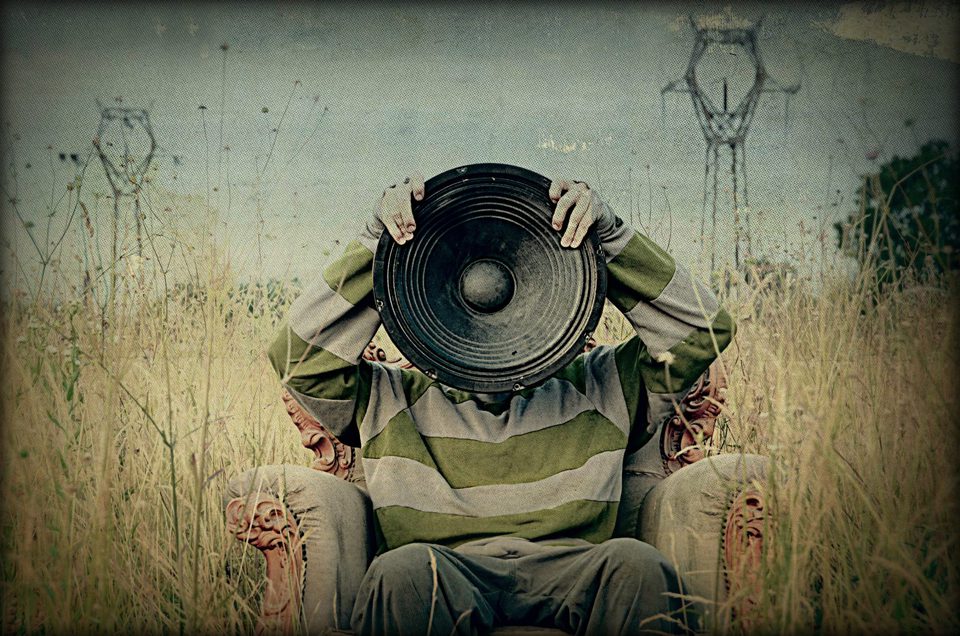Meet the musicians who hunt for sound outside the studio, creating radical new interpretations from the diverse material they discover.
Nick Zammuto lives in southern Vermont, somewhere up in the mountains. When he and his wife bought their property, the only buildings on the 16 acres of land were a tumbledown shack and an old tractor shed, but they had a plan. They fixed the shack up, turning it into the ideal place to raise kids; a picture-perfect house nestled in the field like a chocolate in a box.
However, it’s the tractor shed that’s the most interesting thing on Zammuto’s property. These days, rather than just being an old tractor shed, it has been transformed into a music studio – a self-contained little building with a gently sloping roof, a thick woodpile along one side, and plant boxes by the door. Walk up to it, winding your way through the long grass, and you might notice a set of PVC pipes cut to different lengths and stacked by the door.
Each of these pipes, Zammuto says, is tuned to a specific pitch. In a YouTube video that he made, he deliberately scratches a record at key points, creating something like a very basic, glitchy drum loop. He plays it out through a speaker, putting one of the pipes between it and the mic, and turning the sound into a beautifully tuned piece of music.
Inside the studio, you’ll find guitars, drums, computers and all the sprawling paraphernalia of modern recording. But you’ll also find a stack of VHS tapes, which Zammuto has been picking up from thrift shops for years and is slowly digitising, creating a massive library of obscure and weird samples.
As you may have guessed, Zammuto’s music is a little bit unusual. Formerly a member of the experimental duo The Books, he and his band now make music that draws heavily on what’s commonly known as found sound (think about found art) – sounds created by everyday objects, which are recorded, warped and twisted to suit the needs of the musician. “It’s the way I think of things,” Zammuto says. “When I first started, I was coming out of the visual arts, and I knew nothing about music. I started making sculptures that had a sound component to them, and I had to document them somehow. I fell in love with sound as a sculptural medium; working with little bits and pieces and knitting them together felt much more natural than trying to record a band.”
Using found sound in songs is nothing new – rappers have been using voicemail messages to break up tracks since the days of De La Soul – but in the past few years, there has been a fresh wave of musicians eager to experiment with it. British electronica duo Mount Kimbie, according to writer Aimee Cliff, created music out of the sound of skateboarders, thrown stones and the ambience of a church. Similarly, producer Lukid has drawn on the sound of bus journeys, and there are dozens of others creating music that is usually experimental, often deeply, deeply weird, but always intriguing.
In Rian Johnson’s superb Sci-Fi film Looper, he tapped his cousin Nathan to record the soundtrack. Nathan responded by making a score almost entirely out of found sound; fan belts, crashing metal and angle grinders became the basis for custom-built instruments. The result was unreal – a score that sounded like nothing that had come before it. If you’re looking for proof that gifted composers can take absolutely anything and make it sing, that’s it right there.
Take Daniele Sciolla. The Italian composer has been using found sounds for years, trekking across Europe to get unusual bits of audio. For his amazing track Oldroom, Sciolla says that, in addition to a synth and an old guitar, he travelled to Fribourg in Switzerland, returning with the sounds of computer fans and traffic lights, and plenty of vocal samples. Once he’d mixed all of these together, back at home base, he had come up with something wonderfully unique. These are the type of sounds that innovate and push music forward.
Sciolla and Zammuto exist because it’s easier than ever for them to do what they do. With technology becoming cheaper, musicians no longer have to use complex recording rigs to do this. You can go out with an iPhone and come back with a good set of sounds, although both musicians have reasonably high quality rigs. For Zammuto, part of the attraction comes from the fact that these are sounds that clearly have a purpose, and which had a life outside of music. He says: “I love sounds that feel alive. There is this almost chaotic element that I’m drawn to in music, where time has changed the original in some way. I love the idea of the passage of time, and sound wearing down with it in some way.”
Like any part of music, found sounds come with their own unique set of challenges; it’s rare for a studio musician to have to risk life and limb to record, say, the sound of a lump of sodium being thrown into a swimming pool. However, there are other things to think about and take into consideration, too. Let’s say you’re looking for a sample online – a kick drum, perhaps. You have instant access to millions upon millions of kick drums, some of which are paid for and others that are free. You’re completely spoilt for choice, with neither the time nor possibly the inclination to pick the best one. You might think that having to go out and track down good found sounds simplifies this problem, because you’re limiting yourself creatively to what you can find. Well, that’s not the case. When absolutely every object on the planet, big or small, makes some sort of sound, finding a good or unusual one can be a very difficult task.
“It’s a pretty big world, and there’s a lot out there to record,” says Ric Viers. The Detroit sound engineer might not be a musician exactly, but when it comes to recording found sounds, he’s probably the most knowledgeable person on earth. As head of Blastwave FX, Viers has personally recorded hundreds of thousands of sounds in the field, and written two books on the subject. He knows all too well that getting a really good piece of found sound takes time and practice. “Anything and everything can be used to make sound. I’ve been recording for a long time,” he says, “and even I get stuck in patterns and ruts and routines, and default to the same sources for different things.
Viers continues: “We listen with our ears, and not with our eyes. Whenever we’re in a store – and my wife was making fun of me about this yesterday – I’m always touching things. I will usually walk up to something – any object – and shake it with the full intention of trying to get a sense of what it sounds like.”
Simply recording sounds is only the start. You have to take them back to the studio and work out what the Hell to do with them. “I think it’s easy to record sound outside the studio,” says Sciolla, “but you need some musical knowledge to work with it. You have to fix it in a track … choose the right frequencies, the right pitch, select the best sample.”
The odd thing is that, despite these problems, music is an ideal place for found sounds to be used. When he’s recording effects for his libraries, Viers has to make sure that they’re clean. He has no control over where they’ll be used, and a producer who drops one into a session won’t want other sounds cluttering that nice metallic clang they’ve picked out. But for people like Zammuto and Sciolla, sounds don’t have to be clean. They can have imperfections, and grit, and noise. It gives them character. It gives them what Zammuto calls dirt – something he says he loves.
Viers echoes this: “The effects you record are going to end up buried under all the other instruments. When I record, I have to make sure everything is clean and pristine because it’s going to be naked in a sound effects library. With a song, you can get away with murder.”
In many ways, this is a movement that is only just getting started. When there are literally billions of sounds out there in the wide world just waiting to be recorded and manipulated, it won’t be long before musicians start to look outside of the studio for their next fix. Actually, scratch that “won’t be long” bit. It’s already happening now and it’s incredible.
For further information on the artists mentioned, visit www.ricviers.com, www.zammutosound.com, and www.soundcloud.com/danielesciolla.
Rob Boffard





